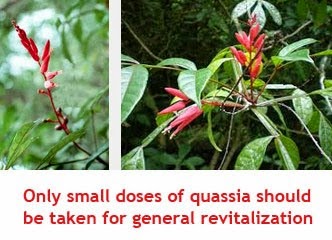Quassia is also known as Jamaican quassia, or bitter ash. It is similar and closely related to Japanese quassia (Picraine ailanthoides) and Surinam quassia (Quassia amara). They are all deciduous trees from tropical America, India or Malaysia. The word "quassia" describes the bitter compound extracted from the wood and bark; at one time brewers used it instead of hops to flavor beer.
Quassia
• What are the origins and characteristics of quassia?
The quassia tree grows very tall - over 80 feet (25 m) - and looks a little like the ash tree. It has small, pale-yellow flowers. The wood is used in the form of chips, which are used to flavor tonic wines and beers. If you fill wooden cups made from this tree with water and leave them to stand overnight, you will have butter drink that is said to be good for stimulation the flow of gastric juices in the stomach and sharpening the appetite.
The quassia tree grows very tall - over 80 feet (25 m) - and looks a little like the ash tree. It has small, pale-yellow flowers. The wood is used in the form of chips, which are used to flavor tonic wines and beers. If you fill wooden cups made from this tree with water and leave them to stand overnight, you will have butter drink that is said to be good for stimulation the flow of gastric juices in the stomach and sharpening the appetite.
• What are the culinary uses?
Quassia chips have an intensely butter taste but no smell. When added to water or alcohol, they produce a yellow color. Quassia is used in the production of butters, which were traditionally used in the spring to increase the secretion of digestive juices and stimulate sluggish stomachs, thus restoring the appetite - especially important after a winter of heavily salted and stodgy food.
Quassia chips have an intensely butter taste but no smell. When added to water or alcohol, they produce a yellow color. Quassia is used in the production of butters, which were traditionally used in the spring to increase the secretion of digestive juices and stimulate sluggish stomachs, thus restoring the appetite - especially important after a winter of heavily salted and stodgy food.
• What are the medicinal uses?
Only small doses of quassia should be taken for general revitalization. Quassia is also used to treat rheumatism and fevers, stomach disorders and dyspepsia. A tea made from the wood chips is said to be a cure for alcoholism, and an infusion used as a shampoo is said to clear up dandruff. It can also be taken internally as a tea to kill roundworms.
Only small doses of quassia should be taken for general revitalization. Quassia is also used to treat rheumatism and fevers, stomach disorders and dyspepsia. A tea made from the wood chips is said to be a cure for alcoholism, and an infusion used as a shampoo is said to clear up dandruff. It can also be taken internally as a tea to kill roundworms.
Sandy is an avid follower of natural cure. She maintain her sites at: http://www.101herbal-remedies.com/ and http://www.101aromatherapy-guide.com/
Article Source: http://EzineArticles.com/?expert=Sandy_A.

No comments:
Post a Comment